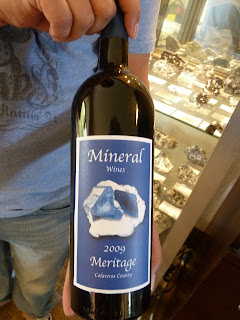We are the staff at the Mineral Sciences Department at the Natural History Museum of Los Angeles County. Associate Curator Dr. Eloïse Gaillou, Curator Emeritus Dr. Tony Kampf, and Collections Manager Alyssa Morgan. This blog is for friends, colleagues and members, anyone interested in hearing about what goes on behind the scenes in a mineral museum.
Much of the mineral specimens in our collection come from donations. We go to mineral shows for a number of reasons. First, we go to buy gems, minerals and meteorites for the museum. Second, we go to catch up with old friends, collectors, dealers, and other museum staff. Finally we also go to exhibit pieces from the collection to show the Tucson crowds what the L.A. County Museum has to offer! We have a fundraising group called the Gem and Mineral Council that museum members can join for additional yearly dues. We offer lectures, classes, field trips, parties and other random mineral related activities. Money raised by the council is used for aquisitions. We need to buy new specimens in order to keep the collection current (to get pieces of the new finds). We also need to be able buy specimens when a good opportunity comes along, like a nice specimen comes on the market that is from California (our specialty) or is a great example of a mineral we do not have in the collection and we have a chance to grab it rather than waiting for someone to donate one.
To kick things things off, we are blogging about our experiences at the Tucson Gem and Mineral Show, from February 2 to February 12, 2012!
First stop are the gem shows, with Eloïse Gaillou and Alyssa Morgan. Eloïse has been curator for exactly one week before we arrive, hah! Fortunately she has been coming to Tucson for seven years, the last four as a Smithsonian post-doc. (She has done a lot of research on formation and color in gemstones including diamonds and opals).
The two largest shows are AGTA (American Gem Trade Assoc.) and GJX (Gem and Jewelry Exchange) at the Tucson Convention Center.
These shows are for people in the gem and jewelry business. Members of the public can only attend as guests, but museum staff can register for these shows as buyers.
Eloïse is looking at gorgeous blue and pink spinels from Burma. Spinel: XAl2O4 where X is usually magnesium but can be other metals like iron, chromium, titanium or manganese). Spinel is beautiful and red spinel was once commonly mistaken for rubies. Later on it became a cheap alternative to sapphires and rubies but now that the secret is out, it is no longer cheap!
Almost all emeralds on the market are coated with oil, to fill in cracks and inclusions. Only the finest quality stones look good without oil.
Tucson is the largest show in the world and dealers come from many different countries, it is a great place to catch up with old friends!
Necklaces, necklaces! So much cheap jewelry, so little time (seriously, Eloïse set a timer, we had 30 minutes to shop).
This is Charles from Palladot, giving us a wonderful donation, a peridot gem cut from a pallasite meteorite! Pallasites contain peridot (a.k.a. forsterite, a.k.a. olivine) in an Iron-Nickel metal matrix. They are believed to be the core mantle boundary of a small planet that was destroyed by a collision in the early years of the solar system. Awesome, a gem from another planet!
Wow that is a lot of benitoite! This is a collection of 133 stones mined and cut between the 1930s and 1950s! A rare gem stone, benitoite (BaTiSi3O9) is only found in large crystals in San Benito County California in a hydrothemally altered serpentinite+glaucophane schist. As a gem, it looks like blue sapphire with high dispersion (rainbow colors, like a prism).
We have many beautiful opals on display in the Gems and Minerals Hall, but we do not have any from Ethiopia. The Wollo opals are really remarkable, some have what looks like the remnants of plant roots and some have what looks like cell structure (but probably isn't):
More aquisitions, this is pezzottaite, Ca(Be2Li)Si6O18. A beryl group mineral. It was found in 2003 in one pocket in a pegmatite near Antsirabe, Madagascar. This was donated by Polychrome minerals, merci Laurent!
The find of the show, this is a 3.23 carat haüyne. Haüyne (how-een), is a rare sodalite group mineral. It is found as tiny crystals in alkalic lavas such as phonolites. It's electric blue color may be due to color centers created by sulfur polymerization! Large crystals like this are incredibly rare and we are thrilled to have found this stone from Eiffel Mountains Germany.












































